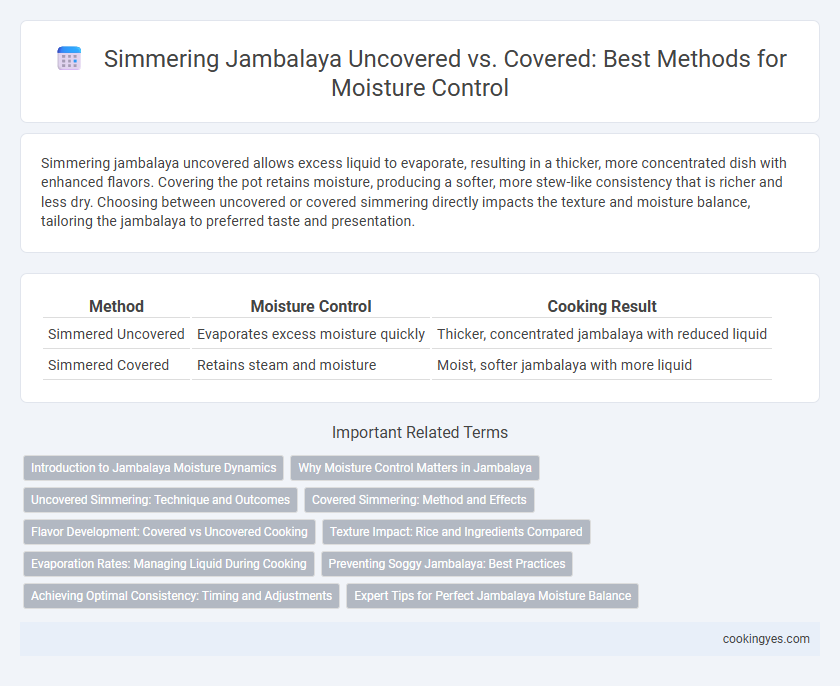Simmering jambalaya uncovered allows excess liquid to evaporate, resulting in a thicker, more concentrated dish with enhanced flavors. Covering the pot retains moisture, producing a softer, more stew-like consistency that is richer and less dry. Choosing between uncovered or covered simmering directly impacts the texture and moisture balance, tailoring the jambalaya to preferred taste and presentation.
Table of Comparison
| Method | Moisture Control | Cooking Result |
|---|---|---|
| Simmered Uncovered | Evaporates excess moisture quickly | Thicker, concentrated jambalaya with reduced liquid |
| Simmered Covered | Retains steam and moisture | Moist, softer jambalaya with more liquid |
Introduction to Jambalaya Moisture Dynamics
Simmering jambalaya uncovered allows moisture to evaporate, concentrating flavors and achieving a thicker, drier texture favored in traditional Creole recipes. Covering the pot traps steam, preserving moisture for a softer, more stew-like consistency suited to Cajun variations. Controlling the lid state during cooking is essential to balance the ideal moisture content and optimize the rice's absorption without overcooking.
Why Moisture Control Matters in Jambalaya
Moisture control in jambalaya is crucial for achieving the perfect texture and flavor balance, as excessive liquid results in a soupy dish while insufficient moisture causes dryness and uneven cooking. Simmering uncovered allows water to evaporate, concentrating flavors and preventing sogginess, whereas covering traps steam, preserving moisture but risking a mushy consistency. Mastering moisture control ensures rice cooks properly, proteins remain tender, and the dish delivers its signature hearty yet cohesive bite.
Uncovered Simmering: Technique and Outcomes
Simmering jambalaya uncovered allows steam to escape, resulting in a thicker, more concentrated dish with enhanced flavor intensity and a slightly caramelized texture. This method helps evaporate excess liquid, preventing the jambalaya from becoming watery while promoting the melding of spices and ingredients. Uncovered simmering requires attentive stirring to avoid sticking and ensures optimal moisture control, delivering a rich and authentic Creole or Cajun experience.
Covered Simmering: Method and Effects
Simmering jambalaya covered retains moisture by trapping steam, resulting in a tender, saucier consistency that melds flavors deeply. The covered method ensures even heat distribution, preventing drying out while allowing rice and ingredients to absorb liquids thoroughly. This technique enhances the dish's rich texture and balances spices more effectively compared to uncovered simmering.
Flavor Development: Covered vs Uncovered Cooking
Simmering jambalaya uncovered allows moisture to evaporate, intensifying flavors and creating a richer, more concentrated taste. Cooking covered traps steam, resulting in a moister, tender dish but with less caramelization and depth of flavor. For bold, complex jambalaya, uncovered simmering enhances flavor development by promoting gradual reduction and browning.
Texture Impact: Rice and Ingredients Compared
Simmering jambalaya uncovered allows excess moisture to evaporate, resulting in a drier, slightly crispier rice texture that separates each grain and intensifies the flavors of the sausage, chicken, and vegetables. In contrast, covering the pot traps steam, creating a moist environment that yields tender, softer rice and a more cohesive blend of ingredients, which benefits dishes emphasizing a saucier consistency. Choosing uncovered or covered simmering directly affects the balance between moisture retention and texture distinction in classic jambalaya preparations.
Evaporation Rates: Managing Liquid During Cooking
Simmering jambalaya uncovered increases evaporation rates, which concentrates flavors and thickens the dish by reducing excess liquid. Covered simmering retains moisture, resulting in a softer texture with more liquid content, ideal for a saucier consistency. Controlling evaporation through uncovered or covered simmering adjusts the dish's moisture balance, ensuring desired texture and flavor intensity.
Preventing Soggy Jambalaya: Best Practices
Simmering jambalaya uncovered allows excess moisture to evaporate, preventing the dish from becoming soggy by maintaining the ideal rice texture. Covering the pot traps steam, which can lead to excess moisture and a mushy consistency in the jambalaya. For optimal moisture control, cook jambalaya uncovered or partially covered, stirring occasionally to ensure even heat distribution and a perfectly balanced texture.
Achieving Optimal Consistency: Timing and Adjustments
Simmering jambalaya uncovered allows excess moisture to evaporate, resulting in a thicker, more concentrated dish, while covering the pot traps steam and retains more liquid for a moister texture. Achieving optimal consistency requires monitoring the cooking time closely, as prolonged uncovered simmering intensifies flavors but risks dryness, whereas covered simmering may necessitate additional cooking to prevent excess moisture. Adjustments such as stirring frequently and adjusting heat ensure the perfect balance between tender rice and flavorful broth.
Expert Tips for Perfect Jambalaya Moisture Balance
Simmering jambalaya uncovered allows excess moisture to evaporate, concentrating flavors and preventing a soupy texture, while simmering covered retains moisture for a softer, stew-like consistency. Expert chefs recommend starting the cooking process covered to meld flavors, then finishing uncovered to achieve the ideal balance between moist and firm rice. Maintaining a controlled simmer temperature and adjusting the lid position ensures perfect moisture retention without sacrificing the dish's signature texture.
Simmered uncovered vs Covered for Jambalaya moisture control Infographic

 cookingyes.com
cookingyes.com